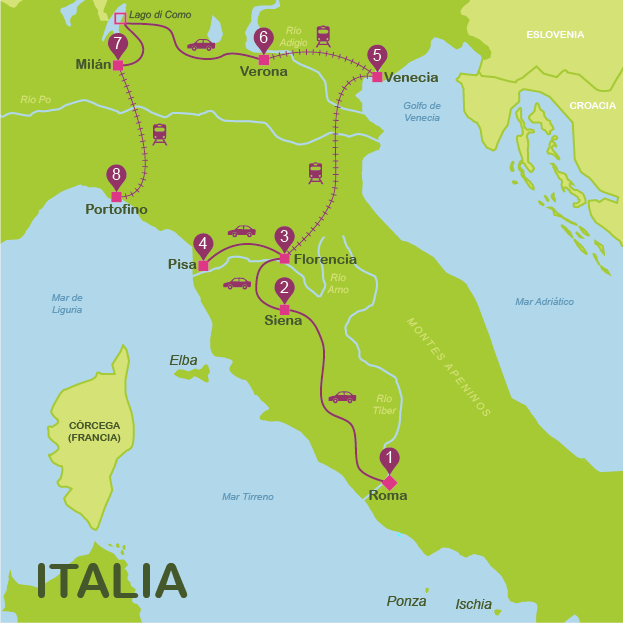
A visit to Pompeii could last a whole day but we point out the most interesting things to see (they are listed according to the numbers on the map that you receive at the entrance). With this explanation you do not have to hire the audio-guide:
2. The Marine Gate: so called because it gives on to the sea, although it was originally known as Neptune´s Gate. It has two openings covered by an arch, one being for pedestrians and the other larger one for animals and carts.
4. Temple of Apollo: the most important religious building in Pompeii. It is thought that as well as Apollo (who is depicted as he is about to fire an arrow), other divinities were worshipped in the temple: Diana the hunter and Mercury.
5. The Basilica: the seat of judicial administration and, together with the Forum, the important building in the city.
6. The Forum: civic centre and heart of Pompeii´s commercial life. There were clay tablets on show to the public where news was written such as the results of the latest election or the date of some show. Some took advantage of them to air complaints and to advertise their businesses. One example found: "Macerior begs the councillor to prohibit people from making noise in the street and bothering decent people when they are sleeping".
11. Macellum: here you can see the reproductions of the bodies of some of the 2,000 victims of the eruption.
12. Temple of Jupiter: incredible views of the city of Pompeii with Vesuvius in the background.
15. Thermal baths of the Forum: they are not the biggest in the city but they are the most elegant and superbly conserved. Two corridors allow you to pass to the frigidarium, where in the centre you can see a circular bath for cold dips; and the tepidarium, decorated with fine stucco from the middle of the first century BC. There is a huge brazier conserved here which was used for heating the atmosphere. The calidarium was the area for hot baths, and the high temperatures were achieved thanks to the hot air which passed through the interior of the double walls.
17. House of the Faun: one of Pompeii´s most luxurious constructions, decorated with stucco and mosaics. On the entrance you can find the greeting AVE (welcome in Latin). In one of the vestibule´s two atriums there is a fountain with a small statue of a dancing faun which gives the house its name (the original is in the National Archaeological Museum in Naples).
39. Lupanar: from lupa (she-wolf in Latin), the name given to prostitutes. This was the most important of the numerous brothels found in Pompeii. The prostitutes were Greek or oriental slave girls. The basement gave access to slaves and the lower classes and had five rooms each with a bed. It is still possible to see erotic paintings on the walls.
40. Termas Stabianas: it had a sophisticated heating system: the hot air circulated under the floor and between the walls. Both the male and female sections consisted of a changing room (apodyterium), a room with a cold water pool (frigidarium), a warm room (tepidarium) and a very well-heated room (calidarium). There were also other installations such as a gymnasium and a large open air swimming pool.
43. Grand Theatre: built in the style of the Greek world and taking advantage of the natural slope of a hill. The space reserved for the spectators was divided into three orders of marble stands. The stage had the three classic doors. It had a large quadrangular portico which is fairly well conserved, where spectators could entertain themselves before the show and during the intervals.

